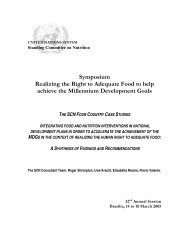Universal Salt Iodization (USI) - FTP Directory Listing
Universal Salt Iodization (USI) - FTP Directory Listing
Universal Salt Iodization (USI) - FTP Directory Listing
- No tags were found...
Create successful ePaper yourself
Turn your PDF publications into a flip-book with our unique Google optimized e-Paper software.
38FEATURES• Elimination of IDD reduces infant and maternal mortality• <strong>USI</strong> reaches boys and girls alike; it helps gender equality• <strong>USI</strong> improves school performance and supports education for all• Reducing IDD helps fight poverty as the poor get an equal chance at a productive lifewww.unsystem.org/scn• <strong>USI</strong> promotes public/private collaboration for development, as health and education sectors work hand inhand with salt producers and food industries.Early success slows momentumIt is clear from the above that there can be no shortage of effective IDD messages. IDD elimination work, toquote a colloquial term, should be a “no brainer.” Among those engaged in IDD communication, the refrainhas been: “Find me a parent who will not knowingly trade his/her last possession for something to protect his/her child’s brain from injury and damage!” Yet, we face lacklustre progress in the last few years. In someareas, <strong>USI</strong> rates have actually retrogressed. Intractable challenges abound.In a way, the very early success has sowed some of the seeds of weakened momentum. There has certainlybeen an IDD fatigue among policy leaders who have in recent years been overwhelmed by many ongoingand emerging dramatic health problems, i.e. malaria, HIV, SARS, and avian flu, to name a few. There is not abroad enough recognition that IDD work is the first global deficiency fight. By definition this requires acontinuous, never ending effort, however simple the compliance behaviour may be, as in the daily use ofiodized salt. Any prolonged interruption of the practice will bring back the full spectrum of IDD, including thedevastating impact on the brain development of fetuses and infants, as surely as the sun rises.Strengthened policy and political support for IDD elimination involving high-level re-advocacy efforts is dealtwith elsewhere in this issue. One needs only to point out the importance of follow-up on politicalannouncements and commitments at the national level. However, national government policy does notautomatically translate into actions at lower levels of governments without concomitant advocacy efforts tomobilize local leaders to carry through with implementation. The 2005 and 2007 World Health Assemblyresolutions on IDD calling for member states to report on iodine nutrition status every three years, forinstance, provide only a framework for action. Without actual advocacy and awareness creation at thecountry level, the resolutions are nothing more than a few sheets of paper languishing in the bureaucraticdrawers of health ministries.Issues and barriers to iodized salt consumptionCommunicating messages at the community and household levels are critical. Among the problems theglobal programme faces are:1. Local leaders, not convinced of the value of <strong>USI</strong>, are not fully committed to wage a vigorous effort.Sometimes they have allowed local salt producers to produce non iodized salt. In many areas where <strong>USI</strong>is seriously lagging, local authorities have ignored the official policy of iodizing all edible salt and evencondoned the sale of illegal salt. Where there are changes of leadership, especially at the communitylevel, new arrivals are often not informed of the IDD threat. Some may assume that their predecessorshave done the job and therefore IDD elimination is no longer a priority. With economic developmentconsiderations dominant in many countries, IDD elimination’s specific economic benefit should be stressedas part of local advocacy efforts.2. Consumers are not fully aware of the specific threat of brain damage in children caused by IDD. In manycountries, IDD elimination programs still provide graphic details of visible goitre and cretinism which oftenovershadow the broader, more serious, public health threat of brain damage in children. A number ofinformal enquiries in a number of countries have shown that the “big neck” or visible goitre effect of IDDstill dominates knowledge among consumers. IDD’s brain damage threat to infants is not highlighted and isoften lost among a plethora of other messages. Some even confuse the benefit of iodized salt with that offluoride. In more than one country, rumors claimed that iodized salt really aimed at prevention ofpregnancies; a hidden weapon of family planning. One unproven hypothesis was that IDD was mistakenSCN NEWS # 35 back to contents







